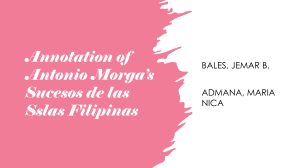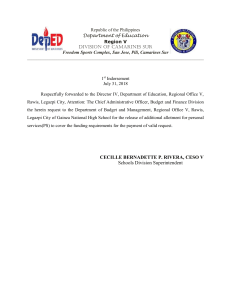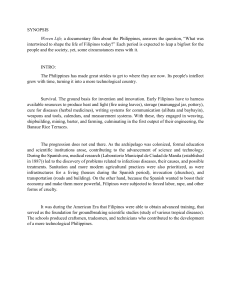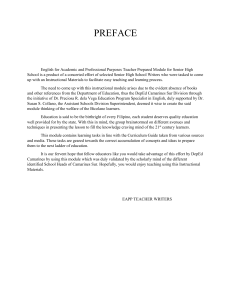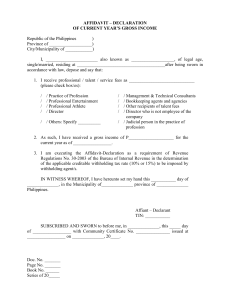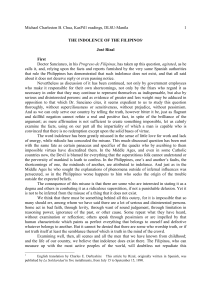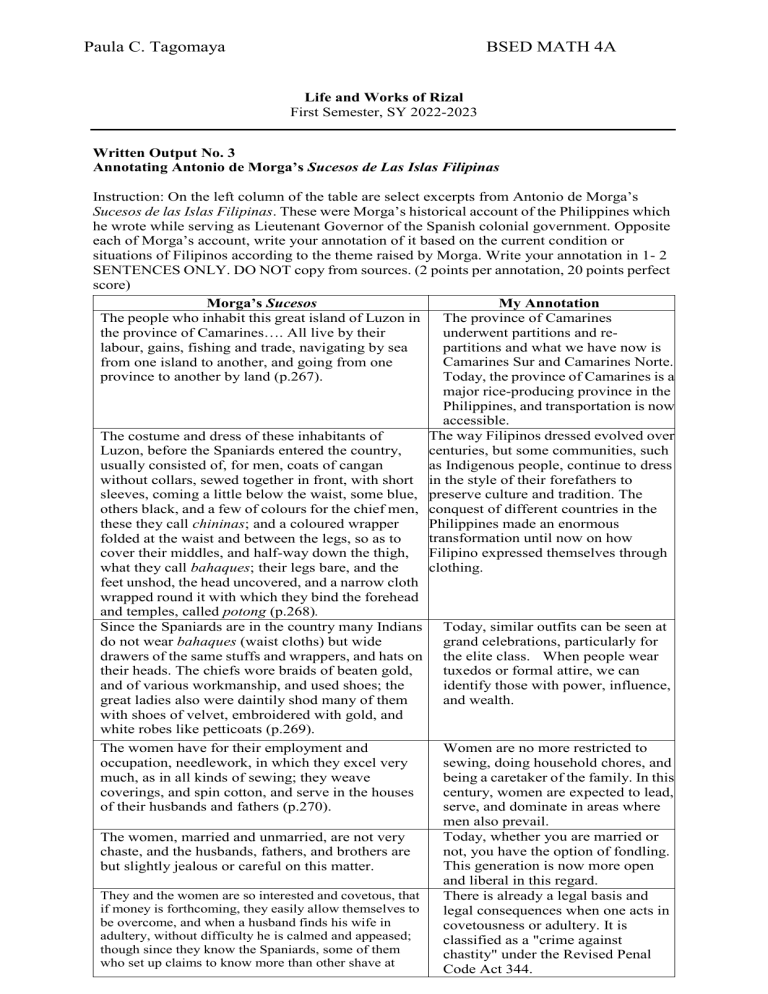
Paula C. Tagomaya BSED MATH 4A Life and Works of Rizal First Semester, SY 2022-2023 Written Output No. 3 Annotating Antonio de Morga’s Sucesos de Las Islas Filipinas Instruction: On the left column of the table are select excerpts from Antonio de Morga’s Sucesos de las Islas Filipinas. These were Morga’s historical account of the Philippines which he wrote while serving as Lieutenant Governor of the Spanish colonial government. Opposite each of Morga’s account, write your annotation of it based on the current condition or situations of Filipinos according to the theme raised by Morga. Write your annotation in 1- 2 SENTENCES ONLY. DO NOT copy from sources. (2 points per annotation, 20 points perfect score) Morga’s Sucesos My Annotation The people who inhabit this great island of Luzon in The province of Camarines underwent partitions and rethe province of Camarines…. All live by their partitions and what we have now is labour, gains, fishing and trade, navigating by sea Camarines Sur and Camarines Norte. from one island to another, and going from one Today, the province of Camarines is a province to another by land (p.267). major rice-producing province in the Philippines, and transportation is now accessible. The way Filipinos dressed evolved over The costume and dress of these inhabitants of Luzon, before the Spaniards entered the country, centuries, but some communities, such usually consisted of, for men, coats of cangan as Indigenous people, continue to dress without collars, sewed together in front, with short in the style of their forefathers to sleeves, coming a little below the waist, some blue, preserve culture and tradition. The others black, and a few of colours for the chief men, conquest of different countries in the these they call chininas; and a coloured wrapper Philippines made an enormous transformation until now on how folded at the waist and between the legs, so as to cover their middles, and half-way down the thigh, Filipino expressed themselves through clothing. what they call bahaques; their legs bare, and the feet unshod, the head uncovered, and a narrow cloth wrapped round it with which they bind the forehead and temples, called potong (p.268). Since the Spaniards are in the country many Indians Today, similar outfits can be seen at do not wear bahaques (waist cloths) but wide grand celebrations, particularly for drawers of the same stuffs and wrappers, and hats on the elite class. When people wear their heads. The chiefs wore braids of beaten gold, tuxedos or formal attire, we can and of various workmanship, and used shoes; the identify those with power, influence, great ladies also were daintily shod many of them and wealth. with shoes of velvet, embroidered with gold, and white robes like petticoats (p.269). The women have for their employment and Women are no more restricted to occupation, needlework, in which they excel very sewing, doing household chores, and much, as in all kinds of sewing; they weave being a caretaker of the family. In this coverings, and spin cotton, and serve in the houses century, women are expected to lead, of their husbands and fathers (p.270). serve, and dominate in areas where men also prevail. Today, whether you are married or The women, married and unmarried, are not very not, you have the option of fondling. chaste, and the husbands, fathers, and brothers are This generation is now more open but slightly jealous or careful on this matter. and liberal in this regard. They and the women are so interested and covetous, that There is already a legal basis and if money is forthcoming, they easily allow themselves to legal consequences when one acts in be overcome, and when a husband finds his wife in covetousness or adultery. It is adultery, without difficulty he is calmed and appeased; classified as a "crime against though since they know the Spaniards, some of them chastity" under the Revised Penal who set up claims to know more than other shave at Code Act 344. Paula C. Tagomaya BSED MATH 4A times killed the adulterers (p.270). All these islands are in many parts rich in gold washings, and in ore of this metal, which the natives extract and work; although since the Spaniards are in the country, they proceed more slowly with this, contenting themselves with what they have already got in jewels, and from a far distant time, and inherited from their predecessors, which is a large quantity, for he must be a very poor and wretched person, who does not possess any chains of gold, bracelets, and earrings (p.283). The language of all the Pintados and Bisayas is one and the same, by which they understand one another, speaking and writing, with letters and characters which they have of their own, and which resemble those of the Arabs; the usual writing of the natives is on leaves of trees, and on canes, upon the bark; for in all the islands there are many with the joints of enormous size, and the roots are very thick and solid trees (p.293). The buildings and houses of the natives of all these Philippines isles are of one same kind, and their towns also because they always construct them on the sea shore between rivers and creeks; the natives usually collecting together in quarters and towns wherever they sow their rice and own their palms, nupa trees, plantain groves, and other trees, and apparatus for fisheries and navigation and fewer number inhabit the interior of the country, who are the Tinguians (p.295). These chiefdoms and lorships were inherited by filiation and succession from father to son, and their descendants; and in default of them, the brothers and collaterals succeeded. Their duty was to rule and govern their subjects and partisans, and assist them in their wants and necessities; and what they received from their subjects was, to be greatly respected and venerated by them, and served in their wars, navigation, and labours of tillage and fishery. And the construction of their houses (p.296). Loans with profit were very ordinary and much practiced, very excessive interest being customer, so as to double and increase the debt, all the time it was deferred, to the whole extent of the principal; and the debtor and his children, when he possessed nothing else, became slaves (p.302). The Philippines is one of the top gold-producing countries in the world. Access to accessories, cutlery, and furniture is now available to everyone, and some regard it as an expression rather than a status symbol. The Philippines is a multilingual country with distinct dialects in each region. We speak a variety of languages and dialects, but the Filipino language is our national language and is used primarily in formal settings. Because of the influence of American architecture, houses are now built with western materials such as concrete walls, and some Filipinos are considering townhouses and condominiums. There is still a community that lives near rivers and seas as a means of subsistence. Chiefdoms and lordships of the past can be compared to the political dynasties of today. Although we are now a democratic country with the freedom to choose our leaders, we cannot deny that they use government as a family kinship, with their sons, daughters, and relatives gaining positions due to their influence. Loans are still evident now and guaranteed because some loans are government insured. It is no longer the case that if a person does not pay his or her debt, his or her children will become slaves; instead, there is a formal agreement of one's asset called collateral.


